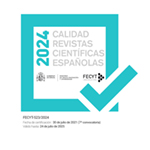Bioarqueología en contextos mortuorios dispersos. El caso de Ojo de Agua, Quebrada del Toro (Salta, Argentina)
Resumen
En este trabajo se presentan los resultados del análisis bioarqueológico de la tumba 8 del sitio Ojo de Agua (Quebrada del Toro, Salta). Con fechados que la ubican hacia el año 1.100 de la era, se caracteriza por ser un entierro secundario que contiene restos humanos sin conexión anatómica y con objetos asociados.
El objetivo consiste en establecer el perfil biológico de los individuos a través de la determinación de edad y sexo, así como el análisis de indicadores de estrés nutricional-metabólico, dieta, infecciones, enfermedades degenerativas y traumas, todo lo cual permite inferir aspectos vinculados al estado de salud y estilo de vida.
El análisis preliminar da cuenta de la identificación de al menos tres adultos, dos juveniles y dos infantiles. Entre los indicadores bioarqueológicos se hallaron evidencias de estrés nutricional metabólico en un individuo de sexo masculino, con una moderada salud bucal en el total de la muestra con 21.05% de caries, 28.04% de restos radiculares y 78.95% de piezas dentales con moderado y alto grado de desgaste del esmalte dental. Las reacciones periósticas afectaron a dos individuos, mientras que los traumas registrados remiten a un caso de tipo accidental y dos probablemente asociados a eventos de violencia interpersonal. Finalmente, el estrés funcional da cuenta de exigencias físicas para algunos, comprometiendo la columna vertebral en el caso de al menos 2 de los 3 individuos adultos.
Descargas
Descarga artículo
Licencia
La Revista Española de Antropología Americana, para fomentar el intercambio global del conocimiento, facilita el acceso sin restricciones a sus contenidos desde el momento de su publicación en la presente edición electrónica, y por eso es una revista de acceso abierto. Los originales publicados en esta revista son propiedad de la Universidad Complutense de Madrid y es obligatorio citar su procedencia en cualquier reproducción total o parcial. Todos los contenidos se distribuyen bajo una licencia de uso y distribución Creative Commons Reconocimiento 4.0 (CC BY 4.0). Esta circunstancia ha de hacerse constar expresamente de esta forma cuando sea necesario. Puede consultar la versión informativa y el texto legal de la licencia.









